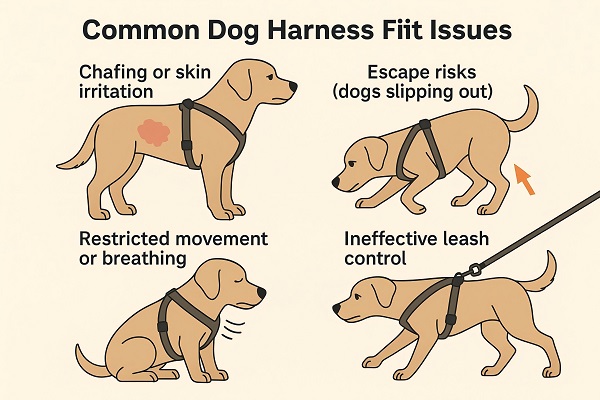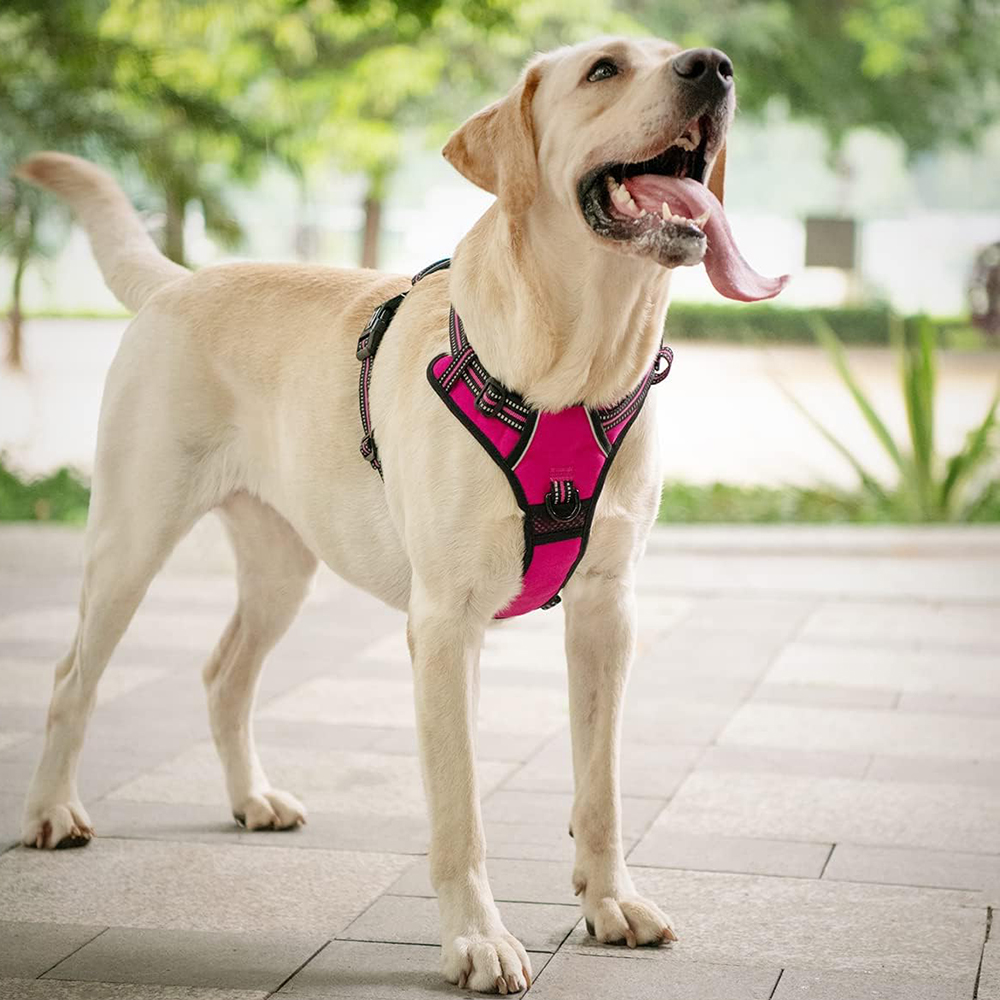A well-fitted dog harness is essential for your pet's safety, comfort, and leash control. Based on customer feedback and internal fitting tests at Minardipets, we’ve found that over 60% of dog owners use harnesses incorrectly, which can lead to serious issues such as:
- Chafing or skin irritation
- Escape risks (dogs slipping out)
- Restricted movement or breathing
- Ineffective leash control

The good news? These problems are entirely avoidable with the right knowledge.
In this comprehensive 2,000+ word guide, Minardipets explains how to fit a dog harness correctly—whether it’s a back-clip, front-clip, or step-in harness—and helps you avoid common fitting mistakes that can lead to discomfort, escape, or injury.
You'll also find clear answers to frequently asked questions such as:
✔ How tight should a dog harness be?
✔ How do I stop my dog from slipping out of the harness?
✔ Which type of harness is best for my dog’s size or breed?
To make this guide even more practical, we’ve included real-life customer testimonials and case studies, showing how a properly fitted harness can improve your dog’s walking behavior and safety.

Best for: Small to medium-sized dogs that do not pull heavily on the leash.
How to Fit:
ü Loosen all straps before putting the harness on.
ü 2. Gently slip the harness over your dog’s head.
ü 3. Fasten the belly strap and adjust it for a snug—but not tight—fit using the two-finger rule.
ü 4. Make sure the leash attachment point sits at the mid-back, not too close to the neck or shoulders.
✅ Pro Tip: A properly fitted back-clip harness reduces pressure on the neck and provides gentle control, making it ideal for dogs that are calm or well-trained.
Customer Testimonial:
"My Beagle, Max, was a notorious escape artist with his old harness. After switching to a properly fitted Minardipets Escape-Proof Back-Clip Harness, walks are now stress-free! The adjustable straps and breathable design make it easy to get the perfect fit, and he hasn’t slipped out once in 3 months." – Sarah M., verified Minardipets customer
FAQ: What harness is best for my small dog? For small or anxious dogs, a soft, lightweight step-in or back-clip harness is usually best. Minardipets offers soft-padded options designed to reduce pressure and improve control.

Best for: Senior dogs, small breeds, or dogs sensitive to harnesses that go over the head.
How to Fit a Step-In Harness:
ü 1. Lay the harness flat on the floor.
ü 2. Gently guide your dog’s front legs into the two openings.
ü 3. Pull the straps up and fasten them securely on the back.
ü 4. Adjust the chest and belly straps snugly—loose straps may cause the harness to twist or rub during walks.
✅ Pro Tip: A step-in harness is often the best dog harness for older dogs or breeds prone to back issues, thanks to its minimal pressure design and ease of use.
Case Study: Helping a Senior Dachshund
My 12-year-old Dachshund, Bruno, has arthritis and hated overhead harnesses. After switching to the Minardipets SoftFit Step-In Harness, designed specifically for senior and small dogs, he immediately walked with more confidence and comfort. No more struggling or stiff movements—we saw a difference within a week!" – James L., Dachshund owner.
FAQ: Is a step-in harness better for older dogs? Yes. Step-in harnesses reduce pressure on the spine and neck, making them ideal for senior dogs or those with mobility issues.

Best for:Large, energetic breeds like Huskies, Labradors, or dogs currently in leash training.
ü How to Fit a Front-Clip Harness:
ü 1. Similar to a back-clip harness, but the leash attaches at the chest, not the back.
ü 2. Ensure the **chest strap sits just above the sternum—never on the throat*—and adjust it snugly to prevent shifting or gapping.
ü 3. Check the side straps for balance to maintain even pressure distribution.
✅ Why It Works: The front clip redirects your dog’s forward pulling force sideways, gently discouraging them from tugging and giving you better control.
Customer Testimonial:
"I was at my wit’s end with my 80-pound Labrador, Duke, who pulled nonstop on every walk. After switching to the Minardipets Control Fit Front-Clip Harness, it was like walking a different dog. The no-pull chest attachment reduced pulling by at least 70% in just two weeks—and now we both enjoy our walks again.-Emma T., Labrador owner
FAQ: Are front-clip harnesses good for training? Absolutely. Front-clip harnesses help redirect pulling and are recommended by trainers for dogs learning leash manners.
Wondering how tight a dog harness should be? Minardipets recommend using the industry-recommended “Two-Finger Rule" to find the perfect fit:
You should be able to easily slide two fingers between the harness straps and your dog’s body.
Too loose? Your dog might slip out or twist the harness during movement.
Too tight? It can restrict breathing, cause skin irritation, or lead to hair loss.
Bonus Tip: Always check for rubbing, redness, or hair wear after walks. These are signs your harness needs adjustment. Test the fit while your dog is standing naturally, as sitting or lying down can change tension.
✅ Minardipets harnesses are fully adjustable around the neck and chest, making it easy to achieve the ideal snug fit for any breed or body shape.
Real-Life Example:
"I thought my Greyhound’s harness was fine until I noticed hair loss under the straps. After loosening it slightly (following the two-finger rule), the irritation disappeared completely."Mark R., Greyhound owner.
Not sure if your dog’s harness is fitted correctly? Minardipets recommend using this quick 30-second checklist before every walk to avoid discomfort, slipping, or injury:
1. Tightness – Use the Two-Finger Rule
Ensure the harness fits snugly but not tightly. You should be able to slide two fingers between the straps and your dog’s body at key points: the neck, chest, and belly.
2. Bottom Strap Position – Avoid Rubbing
The belly strap should sit roughly four fingers behind the front legs, allowing full shoulder movement and preventing friction or irritation.
3. Top Strap Alignment – Chest, Not Neck
The top chest strap (especially in front-clip harnesses) should lie flat across the chest—not too high near the throat and not drooping toward the legs.
Minardipets harnesses are designed with fully adjustable straps, making daily fit checks easy and quick for all dog sizes.
FAQ: Should I check my dog’s harness before every walk? Yes! Daily checks help prevent slipping, rubbing, or accidental escape. Dogs' weight and coat can change, so small adjustments make a big difference.
Even with the best harness, poor fitting habits can lead to discomfort or escape. Below are three of the most common dog harness fitting mistakes—and how to fix them:
❌ Mistake #1: Chest Strap Too High (Near the Throat)
✅ Fix:* Adjust the chest strap so it rests across the upper chest, just above the shoulder joint. This ensures even pressure distribution and avoids choking risks.
❌ Mistake #2: Leaving Extra Room for "Growth"
✅ Fix: While puppies do grow, harnesses should be adjusted monthly, not left loose. A harness that’s too loose can slip or twist during walks.
❌ Mistake #3: Choosing the Wrong Harness Type for Their Breed or Behavior
✅ Fix:
- Small dogs (Chihuahuas, Yorkies): Use a lightweight, step-in harness like the Minardipets Soft Step Harness, designed to avoid neck strain.
- Strong pullers (Huskies, Labradors): Opt for a front-clip or no-pull harness such as the Minardipets Control Fit, which helps redirect pulling safely.
Customer Testimonial:
I didn’t realize my Shiba Inu needed a no-pull harness until I read this guide. The Minardipets Control Fit Front-Clip Harness made walks 10x easier—no more shoulder strain!" – Lisa K., Shiba Inu owner
FAQ: What’s the most common mistake when fitting a dog harness? The biggest mistake is placing the chest strap too high—this can restrict breathing and increase pulling. Always fit based on your dog’s anatomy, not guesswork.
A: Make sure it's snug (two-finger rule), straps are correctly placed, and you're using the right type. Escape-proof harnesses like those from Minardipets help.
A: Yes. Harnesses provide better control and reduce pressure on the neck, making them safer for most dogs.
A properly fitted dog harness isn’t just about safety—it’s about making every walk more enjoyable and stress-free for both you and your dog.
If you're still unsure which style fits your dog's needs, take the next step:
Explore our best-selling solutions like the Minardipets Control Fit Front-Clip Harness for pullers or the Soft Step Step-In Harness for small and senior dogs.
Need help? Contact us today to request a free fitting guide or get personalized harness recommendations** based on your dog’s breed, behavior, and lifestyle.
[Get My Free Fitting Guide] or [Chat with a Specialist]